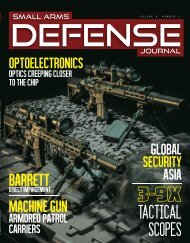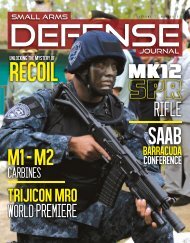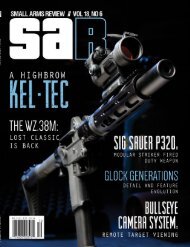Create successful ePaper yourself
Turn your PDF publications into a flip-book with our unique Google optimized e-Paper software.
LEFT: Where the Dror springs were made. ‘Israel,’ the boss, stands in the doorway. (Carl E.<br />
Ekdahl) ABOVE: Where the Dror stampings were made. (Carl E. Ekdahl) RIGHT: ‘Maxie’ Brown<br />
holds a Dror at the factory. This may be one of the smuggled prototypes. (Carl E. Ekdahl)<br />
booklet picturing the plant’s products and<br />
the corporate directors is sole testimony<br />
along with a fragment of the plant that<br />
serves as a grocery store today.<br />
Grant also wondered why Slavin<br />
chose Toronto and suspected it was the<br />
lower wages of machinists. Keeping the<br />
project away from prying eyes probably<br />
played a role, but, Slavin was also an unapologetic<br />
and vocally self-styled “stereotypical<br />
Jew,” begrudging the cost of every<br />
coffee billed to his homeland. When Slavin<br />
had sent Alper around New York on various<br />
missions, he specified circuitous<br />
routes on subway and bus; very seldom<br />
a cab. Alper never doubted the careful<br />
routing was for security. He learned much<br />
later that the long routes, the crowds and<br />
the confusing transfers were actually to<br />
save a few pennies.<br />
Satisfied Toronto was the place,<br />
Slavin called for Alper and Ekdahl to<br />
join him. Local connections found them<br />
space. Working over a luxury car showroom<br />
on Bay Street, their separate entrance<br />
and the constant noise of cars and<br />
car repairs was a perfect cover. Industrial<br />
Research Labs could set up as soon<br />
the landlord saw their references.<br />
Once again, Levine stepped in to<br />
co-sign the lease.<br />
Throughout the war years,<br />
for miles around York Arsenals,<br />
sub-contractors turned and formed<br />
parts for bombs and shells. The<br />
most highly skilled workers sculpted<br />
precision tools. Most now<br />
thrived in peacetime. Grant knew<br />
them all. Ekdahl and Slavin pored<br />
over the gun’s design to identify<br />
what would be changed. Grant recruited<br />
Max Brown and they began<br />
ordering the custom tools for the<br />
1,500 steps to make The Gun. They divided<br />
the work between the machine shops so no<br />
outsider could see the whole picture. Parts<br />
that couldn’t be explained away had to be<br />
made over the showroom. As the orders<br />
came in, parts were made and assembled.<br />
The Gun had to be ready to build on<br />
arrival; there could be no experiments in<br />
Palestine. Slavin determined to build six<br />
prototypes with all the tools made, proven,<br />
labeled and coded for shipping.<br />
There were a few hitches. Everything<br />
outside the tool room seemed to need community<br />
approval and local businessmen,<br />
Rabbis and others hovered around the<br />
clandestine work. Toronto’s Jewish community,<br />
terribly curious, was anxious to<br />
help the cause, but proudly avoided ‘shop<br />
talk’ at lunches and suppers with the mysterious<br />
strangers. All the attention came<br />
to a head one winter night when police<br />
stopped a truck on the highway and looked<br />
in the back.<br />
SADEFENSEJOURNAL.COM 59









